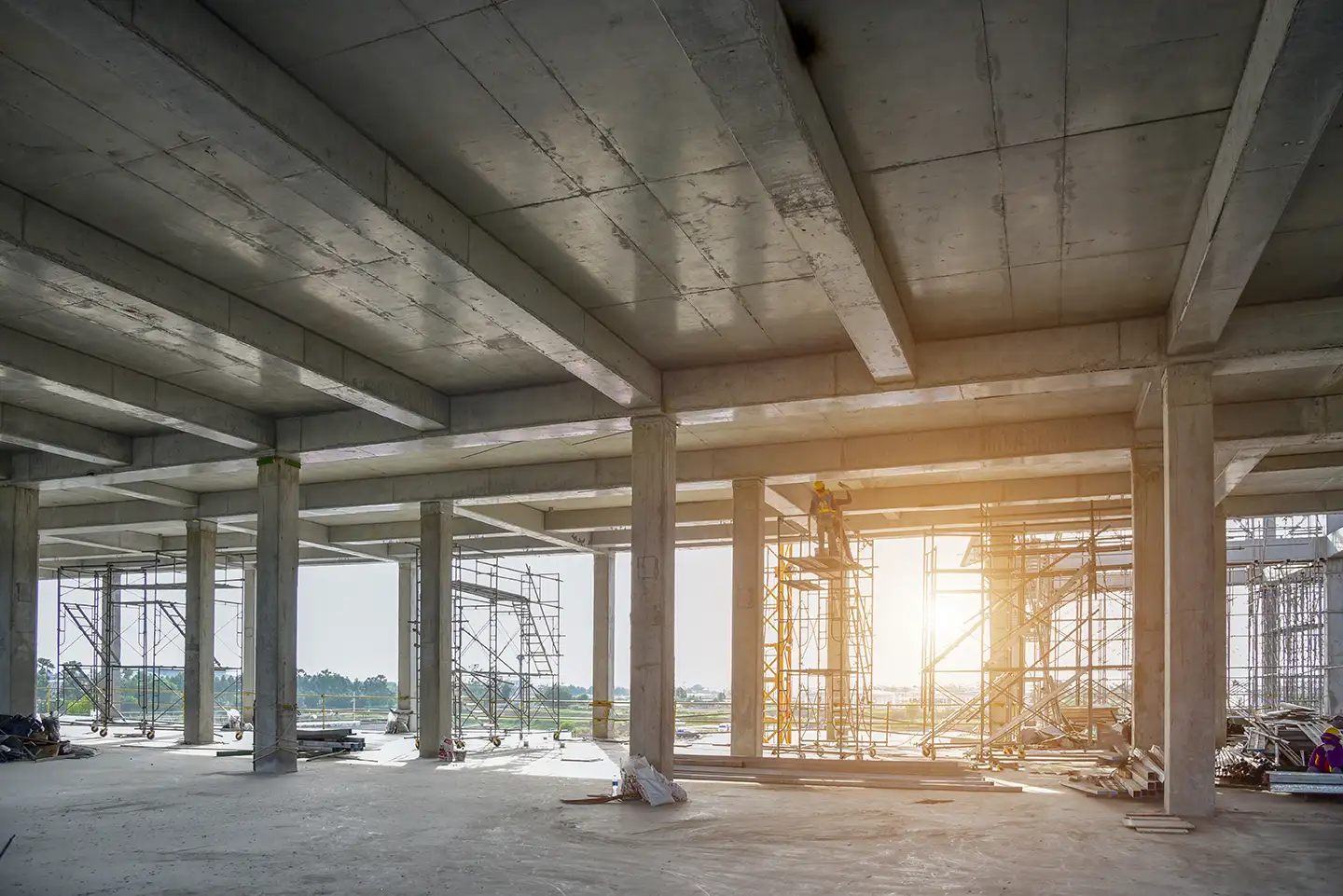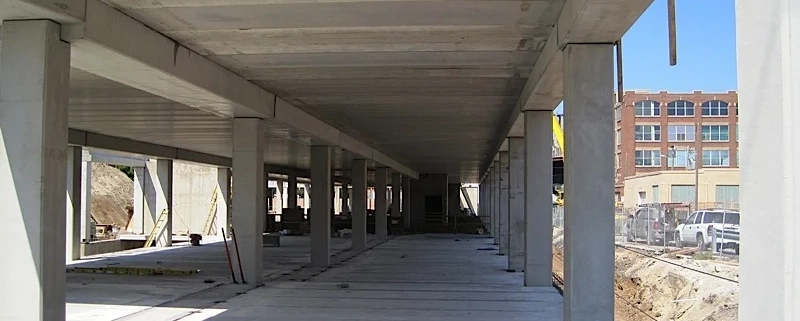Concrete Column Strengthening: Reinforcing the Backbone of Your Building
When you think about the structural integrity of your commercial building in Toronto or the Greater Toronto Area, concrete columns might not be the first thing that comes to mind. Yet these vertical support elements are quite literally holding up your entire structure. As buildings age and environmental conditions take their toll, concrete columns can deteriorate, compromising the safety and stability of your property. Understanding concrete column strengthening and when it’s necessary can mean the difference between a minor restoration project and a catastrophic structural failure.
For property owners across the GTA, the harsh Canadian climate presents unique challenges to concrete structures. The freeze-thaw cycles that characterize Toronto winters, combined with road salt exposure and moisture infiltration, can accelerate column deterioration. This makes concrete column strengthening not just a reactive measure, but often a proactive investment in your building’s longevity.
Understanding Concrete Column Deterioration
Before exploring strengthening solutions, it’s important to understand why concrete columns weaken over time. In the Greater Toronto Area, several factors contribute to concrete column degradation that make the services of a concrete restoration contractor essential.
Environmental Factors Affecting Toronto Buildings
Toronto’s climate is particularly harsh on concrete structures. Winter temperatures regularly plunge below freezing, while summers can be humid and hot. This temperature fluctuation causes concrete to expand and contract repeatedly, creating microcracks that allow moisture penetration. When water enters these cracks and freezes, it expands by approximately nine percent, forcing the cracks wider in a destructive cycle known as freeze-thaw damage.
Additionally, de-icing salts used throughout the GTA during winter months introduce chlorides into concrete. These chlorides can reach the steel reinforcement bars (rebar) inside columns, causing corrosion. As rebar corrodes, it expands, creating internal pressure that causes concrete to crack and spall from the column surface.
Structural and Design-Related Issues
Beyond environmental factors, concrete columns can deteriorate due to original design limitations or changing building use. Older buildings in Toronto’s core may have been designed for lighter loads than they currently carry. As buildings are renovated and repurposed, columns that were adequate for their original purpose may require strengthening to meet current Ontario Building Code requirements.
Inadequate concrete cover over reinforcement, poor concrete quality, or construction defects can also lead to premature column deterioration. For property owners, recognizing the signs of column distress early allows for timely intervention by a qualified concrete foundation repair contractor.

Why Concrete Column Strengthening Matters
The importance of maintaining and strengthening concrete columns cannot be overstated. These structural elements perform critical functions that directly impact building safety, property value, and operational continuity.
Safety and Structural Integrity
Concrete columns transfer the weight of your building’s floors, roof, and contents down to the foundation. When columns are compromised, the entire load-bearing system is at risk. Visible signs like spalling concrete, exposed rebar, vertical cracking, or concrete delamination indicate that a column’s capacity is diminishing. Left unaddressed, column failure can lead to partial or complete structural collapse.
In the Greater Toronto Area, where many commercial buildings date back several decades, regular assessment by contractors experienced in concrete restoration is essential. The Ontario Building Code sets strict requirements for structural capacity, and building owners have a legal obligation to maintain their properties in safe condition.
Economic Considerations
From a financial perspective, concrete column strengthening is typically far more cost-effective than column replacement. Strengthening existing columns avoids the extensive shoring, demolition, and reconstruction required for full replacement. This translates to less disruption to building operations, shorter project timelines, and lower overall costs.
For property owners in competitive Toronto real estate markets, maintaining structural integrity also protects property values. Buildings with documented structural issues face challenges during sale or lease negotiations, while properties with proper maintenance records and recent strengthening work command premium values.
Common Methods of Concrete Column Strengthening
Concrete restoration contractors employ several proven techniques for strengthening deteriorated or underperforming columns. The appropriate method depends on the column’s condition, the required increase in load capacity, and site-specific constraints.
Concrete Jacketing
Concrete jacketing involves adding a layer of new concrete around the existing column, effectively increasing its cross-sectional area and load-bearing capacity. This traditional method is particularly effective for columns with moderate deterioration and where increased column dimensions are acceptable.
The process begins with surface preparation, removing loose or damaged concrete and cleaning existing reinforcement. Contractors then install additional steel reinforcement around the column before casting new concrete. For projects in Toronto’s dense urban environment, concrete jacketing offers the advantage of using readily available materials and established construction techniques that meet provincial building standards.
Steel Jacketing
Steel jacketing involves encasing a concrete column in steel plates or angles, which are then filled with grout or epoxy. This method provides excellent strength enhancement while adding minimal dimension to the column, making it ideal for space-constrained applications common in older Toronto buildings.
Steel jackets can be particularly effective when columns need to resist lateral loads or seismic forces. The steel provides confinement to the concrete core, improving both axial and flexural capacity. For GTA properties, steel jacketing also offers good performance in addressing corrosion-related damage, as the steel jacket can be designed to protect the existing concrete from further environmental exposure.
Fiber-Reinforced Polymer (FRP) Wrapping
FRP wrapping represents a modern approach to concrete column strengthening that has gained popularity among concrete foundation repair contractors in Toronto. This method involves wrapping columns with high-strength carbon fiber or glass fiber sheets saturated with epoxy resin.
FRP systems offer several advantages for GTA projects. The materials are lightweight, making them easier to handle in buildings with limited access. The installation process is relatively quick, minimizing disruption to building occupants. FRP wraps add virtually no dimension to the column, preserving floor space and architectural details. The composite materials resist corrosion, making them well-suited to Toronto’s harsh environment.
The effectiveness of FRP strengthening depends on proper surface preparation and installation quality. The concrete surface must be clean, dry, and properly profiled to ensure adequate bonding. For this reason, property owners should work with experienced contractors who understand both the material properties and local climate considerations.
Post-Tensioning
Post-tensioning involves installing high-strength steel tendons around or through existing columns and then tensioning them to compress the concrete. This method is less common for column strengthening but can be effective in specific situations, particularly for columns supporting heavy loads.
While post-tensioning requires specialized expertise, it can provide significant strength increases with minimal change to column dimensions. In Toronto’s commercial sector, this technique might be considered for heritage buildings where maintaining original column profiles is important.
The Assessment and Strengthening Process
Successful concrete column strengthening begins long before any physical work occurs. A systematic assessment and planning process ensures that the chosen strengthening method addresses the actual structural deficiencies while meeting budgetary and scheduling requirements.
Initial Evaluation and Testing
A qualified concrete restoration contractor begins by conducting a thorough visual inspection of all columns, documenting cracks, spalling, deflection, or other distress signs. Non-destructive testing methods like ultrasonic testing, ground-penetrating radar, or cover meters help assess internal conditions without damaging the structure.
For older buildings in Toronto, core samples may be extracted to test concrete strength and analyze chloride content. This information helps contractors determine whether deterioration is primarily environmental or structural, guiding the selection of appropriate strengthening methods.
Engineering Analysis and Design
Following assessment, structural engineers analyze the existing column capacity and compare it to current and anticipated loads. This analysis considers Ontario Building Code requirements, which may have changed significantly since the building’s original construction.
The engineering design specifies the strengthening method, materials, and installation procedures required to achieve target strength levels. For GTA projects, the design must account for local conditions including freeze-thaw exposure, seismic requirements, and fire resistance ratings specified by provincial codes.
Implementation and Quality Control
During construction, proper surface preparation is critical for all strengthening methods. Contractors remove deteriorated concrete, clean or replace corroded reinforcement, and prepare surfaces according to specifications. Quality control measures ensure that materials meet design requirements and installation procedures are followed precisely.
Weather conditions play an important role in Toronto. Concrete work generally requires temperatures above freezing, while FRP installation needs dry conditions and specific temperature ranges for proper epoxy curing. Experienced contractors plan project schedules around seasonal constraints to ensure optimal results.
Local Climate Considerations for Toronto Properties
Toronto’s unique climate demands special attention when planning and executing concrete column strengthening projects. Understanding these local factors helps property owners make informed decisions and set realistic expectations.
Managing Freeze-Thaw Cycles
The approximately 50 freeze-thaw cycles Toronto experiences annually make proper concrete protection essential. Any strengthening system must either protect the column from moisture infiltration or use materials that can withstand repeated freezing and thawing without degradation.
For jacketing methods, contractors must ensure the new concrete has adequate air entrainment to resist freeze-thaw damage. Proper curing is essential, which may require temporary heating during cold-weather construction. FRP wraps can provide excellent moisture protection when properly sealed at top and bottom, preventing water from reaching the underlying concrete.
Addressing De-Icing Salt Exposure
For columns in parking structures, ground-level retail spaces, or loading areas where road salt exposure is common, strengthening designs must address chloride-induced corrosion. This might involve applying protective coatings to reinforcement before jacketing, specifying low-permeability concrete mixes, or using corrosion-inhibiting admixtures.
Contractors serving the Greater Toronto Area should also consider the ongoing maintenance requirements after strengthening. Periodic inspections and minor repairs can prevent small issues from becoming major problems, extending the service life of strengthened columns.
Protecting Your Commercial Property
Concrete column strengthening represents a critical investment in your commercial building’s safety, functionality, and value. For property owners across the Greater Toronto Area, understanding the deterioration mechanisms affecting concrete structures and the strengthening options available enables proactive management of your building’s structural health.
Whether your columns show visible signs of distress or you’re planning renovations that will increase building loads, working with an experienced concrete restoration contractor ensures that strengthening work meets current building codes and provides long-term performance. The harsh Toronto climate demands expertise in both structural engineering and local construction practices to deliver results that withstand freeze-thaw cycles, de-icing salt exposure, and the other challenges facing GTA buildings.
At Nusite Group, we bring over 30 years of experience in concrete foundation repair, restoration, and waterproofing services to commercial properties throughout Toronto and the Greater Toronto Area. Our comprehensive approach to concrete column strengthening combines thorough structural assessment, proven strengthening techniques, and detailed quality control to reinforce the backbone of your building. From initial evaluation through project completion, our team delivers the trusted, competent service that Toronto property owners depend on.
Don’t wait for minor column deterioration to become a major structural concern. Contact Nusite Group today to schedule a professional assessment of your building’s concrete columns and learn how our expertise in concrete foundation repair and restoration can protect your property investment for decades to come.



